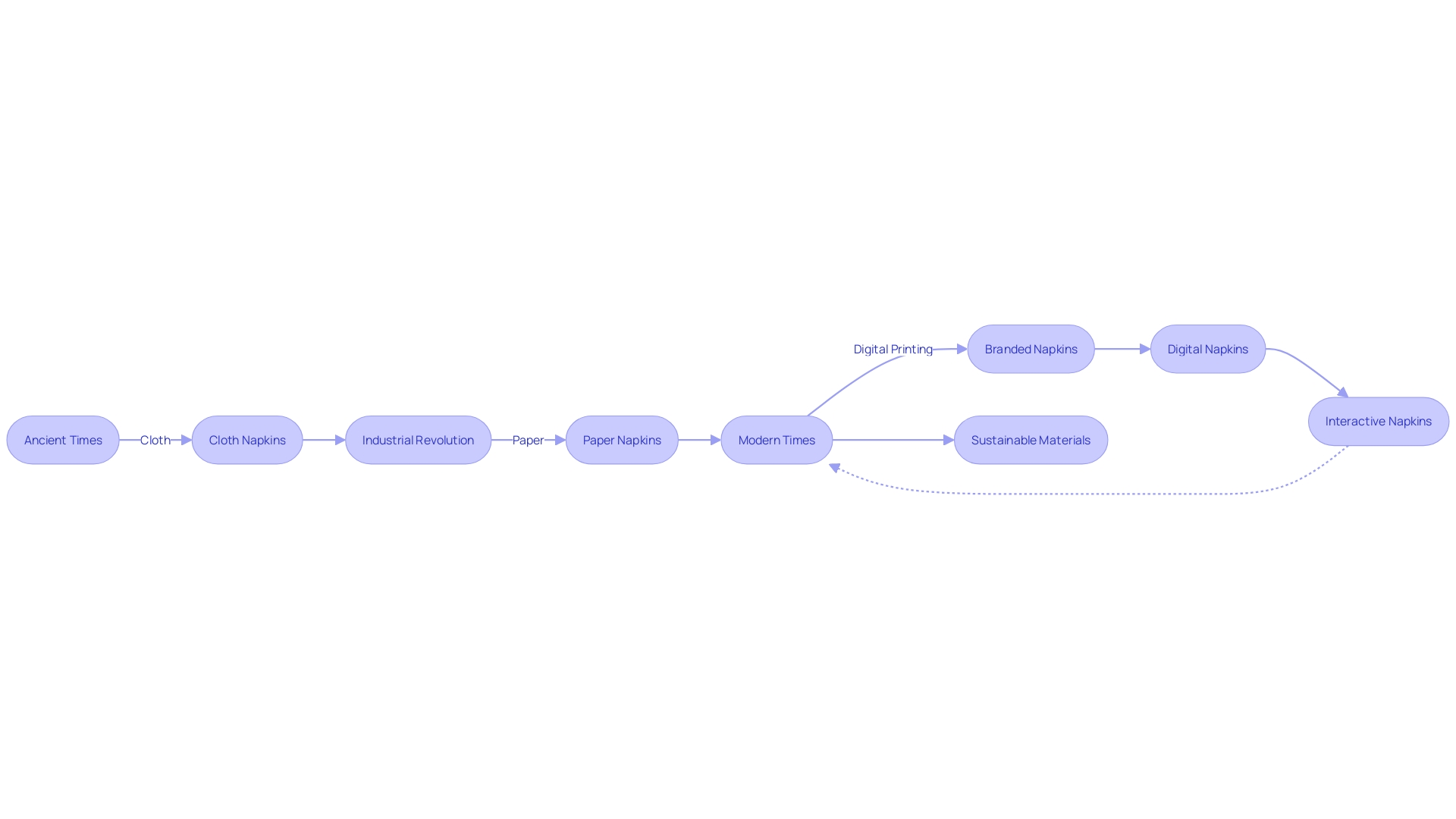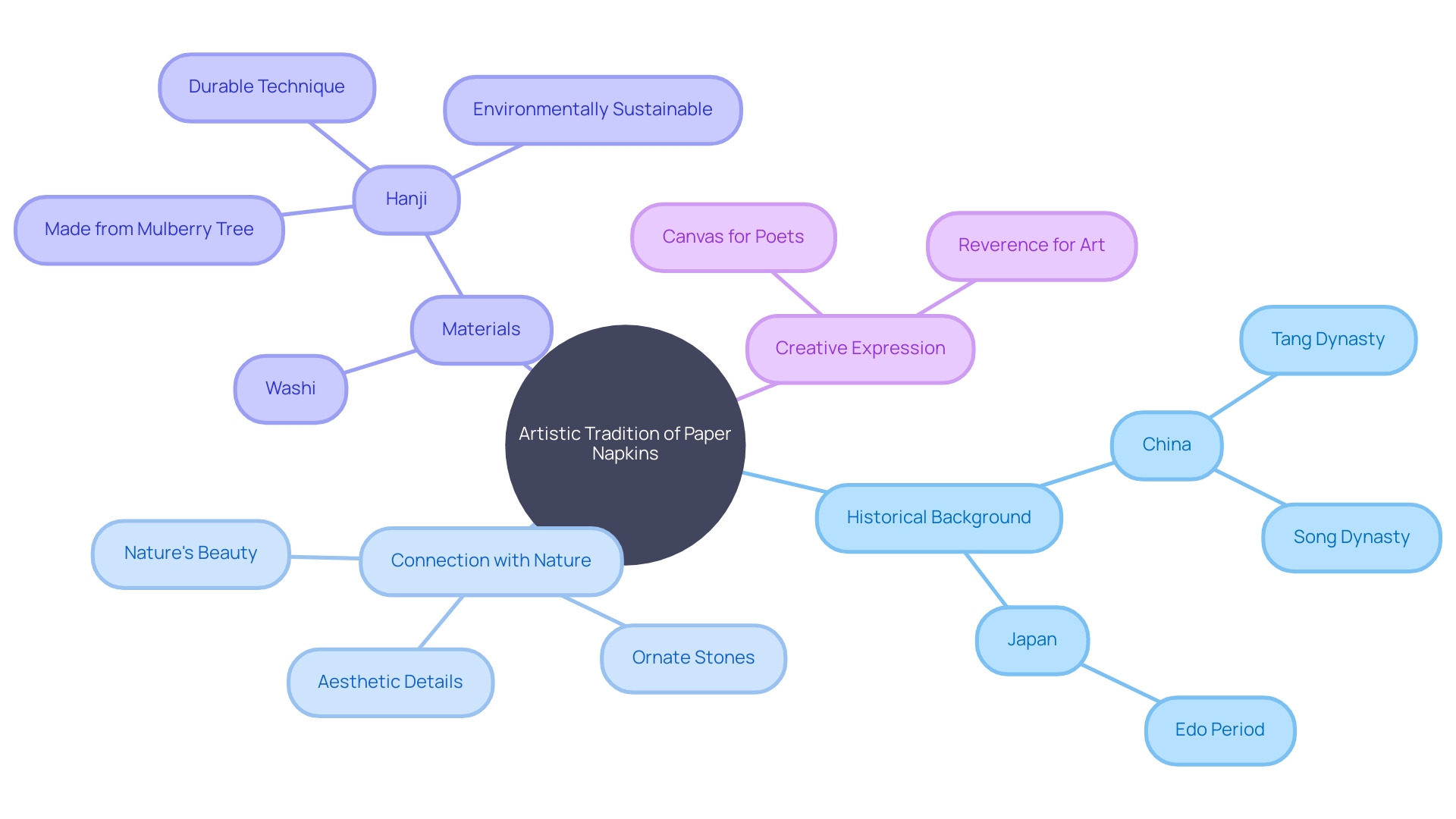Introduction
From the clinking of cutlery to the murmur of conversation, the dining experience is enriched by details, including the humble napkin. Far from being a mere afterthought, the evolution of napkins is steeped in history, tracing back to ancient times when various materials served to wipe hands and mouths. Today’s napkins are not just practical; they are canvases for communication, bearing messages that connect brands with diners through innovative marketing.
This article explores the historical origins of napkins, the emergence of paper napkins, their significance in ancient Chinese and Japanese cultures, their adoption in Western society, their role in etiquette and social acceptance, a comparison with cloth napkins, and the modern use and design of paper napkins. Join us on this journey to discover the enduring significance and adaptability of this everyday item.
Historical Origins of Napkins
From the clinking of cutlery to the murmur of conversation, the dining experience is enriched by details, including the humble napkin. Far from being a mere afterthought, the evolution of napkins is steeped in history, tracing back to ancient times when various materials served to wipe hands and mouths. The term ‘napkin’ itself is a nod to the past, originating from the Old French ‘nape’ for tablecloth, and it signifies more than disposable convenience; it’s a witness to the march of human progress, from the vibrant napkin found aboard the Anne-Marie ship of 1807 to the digital revolution in today’s dining culture.
Today’s napkins are not just practical; they are canvases for communication, bearing messages that connect brands like BetterHelp with diners through innovative marketing like Napkins. This clever approach leverages the average 45-minute stay of a dining party to engage customers in a direct and personal way. As the dining table has always been a place for sharing and exchange, so too has the napkin evolved to facilitate new forms of interaction and cultural exchange, a testament to the adaptability and enduring significance of this everyday item.

The Emergence of Paper Napkins
Once a simple accessory at the dining table, paper napkins have unfolded into a tale of innovation and practicality. Their journey from the monochrome serviettes of the late 1800s to the modern marvels of convenience mirrors the transformative history of paper itself. Each napkin we use today is a descendant of the same fibrous material that has been engineered into everything from cardboard boxes to the sleek pages of a book.
The industry’s evolution has seen a dramatic shift in the consumption of paper for printing and writing, with a 50 percent reduction reported by the American Forest and Paper Association, reflecting a broader trend toward digital alternatives.
Despite this decline, the demand for paper napkins remains resilient, as they are essential for maintaining cleanliness and hygiene, a sentiment echoed by the Cleaning and Hygiene Suppliers Association when they set standards to combat ‘shrinkflation’ in the industry. The tactile experience of paper is irreplaceable, a sentiment shared by designers showcased by Takeo Co. who harnessed paper’s unique sensory properties in innovative packaging solutions. These designers, like Apple’s Susan Kare with her iconic Macintosh icons, appreciate the clarity and simplicity that paper can offer.
In the world of paper napkins, the focus is not just on the functional aspect but also on the environmental footprint. As a procurement manager, one understands the importance of eco-friendly practices. Paper and paperboard packaging, which includes napkins, is celebrated for being recyclable, biodegradable, and sourced from renewable resources.
This commitment to sustainability is vital as industries grapple with environmental concerns.
The versatility of paper napkins today is a testament to the material’s enduring relevance and adaptability. They not only serve a practical purpose but also reflect a history of innovation, a commitment to quality, and an ongoing dialogue with environmental sustainability. The disposable napkin, ever so humble, stands as a symbol of the balance between tradition and progress, between the past and the future of material science.
Paper Napkins in Ancient China and Japan
Diving into the rich tapestry of Chinese and Japanese cultures, one discovers that paper napkins are not a novel invention but rather an artistic tradition deeply rooted in history. The ancient Chinese scholars, known for their appreciation of nature’s beauty, would have been familiar with ‘hanji’ napkins, considering their penchant for collecting ornate stones and their meticulous attention to the aesthetic details in their gardens and studies during the Tang and Song Dynasties. Similarly, the Japanese, during the Edo period, a time of flourishing culture and bustling city life, likely used ‘washi’ napkins alongside the vivid scenes on Nihonbashi bridge, where every object down to the umbrellas and carts was a reflection of their intricate craftsmanship.
These early versions of paper napkins were not merely functional but also a canvas for creative expression, echoing the sentiments of poets and echoing the reverence for art that pervaded these ancient societies.

Adoption in Western Society
Paper napkins have a storied past, intertwined with the evolution of modern dining and the rise of convenience culture. Initially, they were more than just a utilitarian tool to maintain cleanliness; they were emblems of elegance at a time when formal dining was blossoming. This shift towards practicality over tradition is seen in how paper napkins did away with the repetitive chore of laundering their cloth ancestors, streamlining the dining experience.
They represent an interesting dichotomy: a simple product born from the need for efficiency, yet deeply rooted in the fabric of societal change and expectation.

Etiquette and Social Acceptance
As the world becomes increasingly interconnected, the simple paper napkin has emerged as a subtle yet powerful tool in navigating social intricacies. With dining experiences enriched by a tapestry of cultural norms, the paper napkin offers a universal means to maintain decorum. Its role extends beyond mere practicality; it’s a canvas for etiquette, allowing diners from diverse backgrounds to discreetly manage spills and smudges, promoting a shared sense of respect and consideration.
Reflecting on the insights from the Cleaning and Hygiene Suppliers Association (CHSA), it’s clear that the integrity of such dining staples is paramount. Since 1997, the CHSA has championed quality and consistency in cleaning products, including the humble blue roll, a close relative of the paper napkin. This commitment to excellence ensures that not even ‘shrinkflation’—the practice of subtly reducing product size to cut costs—can undermine the dining experience.
Whether in a mac ‘n cheese joint in California or a fine dining establishment, the reliability of paper products is non-negotiable.
In the fabric of our social interactions, paper napkins serve as unspoken guardians of civility. Dr. Clinton Lee, of the Asia Pacific Wine and Spirit Institute, echoes the sentiment that manners may vary, but the essence of politeness is universal. The napkin, thus, becomes an ally in upholding the etiquette that varies from one culture to another.
Moreover, the resilience of the paper napkin industry, as evidenced by online food ordering statistics, underscores its relevance. Despite the fluctuations of the hospitality sector during the pandemic, the demand for paper goods remains a testament to the enduring nature of this simple yet essential product. Amidst the 80% of U.S. diners who continue to order online frequently, paper napkins maintain their place at the table, ensuring that the nuances of dining etiquette are upheld in homes across the country.
Comparison with Cloth Napkins
The landscape of dining accessories is an interesting realm where both tradition and innovation find their place. Cloth napkins, with their rich textures and luxurious feel, have long been a symbol of elegance, often chosen for their ability to be reused and their lesser impact on the environment compared to their paper counterparts. The environmental concerns associated with non organic cotton, which demands a high level of chemical treatments, highlight the importance of seeking sustainable fabric options for those who opt for the sophistication of cloth napkins.
On the other hand, the convenience and affordability of paper napkins cannot be overlooked. Their diverse range of styles and designs cater to a variety of settings, from casual eateries to formal events. Innovations in the industry have led to more eco-friendly options, such as paper napkins made from recycled materials, aligning with a growing consciousness about the environmental footprint of our choices.
The shift towards sustainability in everyday products is reminiscent of the broader changes in industries like publishing, where reducing waste and improving resource management have become priorities.
Bulk purchasing further amplifies the benefits of paper napkins for businesses. By investing in large quantities, companies can reduce their expenses due to lower unit costs, ensuring that the essential task of maintaining cleanliness doesn’t become a financial burden. Moreover, the opportunity to brand these paper napkins presents an additional advantage, turning a simple utility into a marketing tool that subtly enhances a business’s image.
In the grand scheme, whether one leans towards the timeless charm of cloth or the practicality of paper, the decision is shaped by a variety of factors, including environmental impact, cost effectiveness, and the statement one wishes to make in their dining presentation. As we navigate these choices, the words of textile innovators resonate, reminding us of the potential for everyday objects to transcend their traditional roles and offer new dimensions of beauty and functionality.
Modern Use and Design of Paper Napkins
Paper napkins, once a mere afterthought at the dining table, have blossomed into canvases of creativity and style. Like the playful hand-cut McDonald’s paper bags in Norway that mimic the quaint architecture of local apartments, paper napkins now tell a story and set the scene for various dining occasions. Artists and designers have embraced the versatility of paper, as seen in the craft of jewelry design where paper models often precede the final product, embodying the intricate relationship between concept and creation.
Similarly, napkins have become an integral part of table aesthetics, with designs ranging from the sophistication of a furoshiki-inspired wrap to the bold statement of modern art. These small yet significant details are part of a broader trend acknowledging the power of paper to transform our dining experiences into moments of beauty and expression. In a world that yearns for tactile experiences amid the digital age, the humble paper napkin has risen to the occasion, offering a touch of elegance and a flourish of creativity that resonates with consumers seeking to capture that ‘wow’ moment in everyday life.
Conclusion
Napkins have a rich history, evolving from mere practical items to canvases for communication. Paper napkins, despite digital alternatives, remain resilient due to their essential role in cleanliness and their tactile experience. In Chinese and Japanese cultures, paper napkins were artistic expressions of beauty and craftsmanship.
In Western society, they streamline dining experiences and promote decorum across diverse backgrounds. When compared to cloth napkins, paper napkins offer convenience, affordability, and a range of styles while aligning with sustainability efforts. Modern paper napkins have become creative and stylish additions to dining occasions.
Overall, napkins connect brands, cultures, and individuals, enriching the dining experience and telling stories. So next time you reach for a napkin, remember its journey and the enduring significance it holds.
